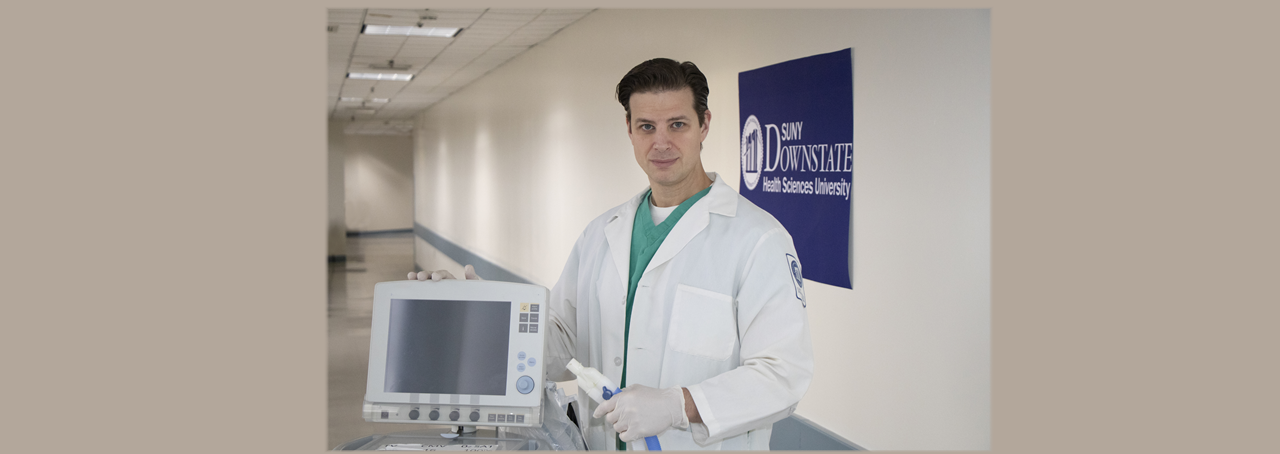SUNY Downstate research guides national COVID-19 protocols
Desperate times call for desperate measures. As the number of hospitalized COVID-19 patients continues to surge, there is growing concern about a shortage of the life-saving ventilators needed to help these patients breathe.
SUNY Downstate Emergency Medicine physician and Assistant Director of Research Lorenzo Paladino, M.D., collaborated with the White House Coronavirus Task Force and other experts to develop national protocols based on his 2008 research showing that a single ventilator could be used to support up to four people. “It is not the ideal way to offer breathing support, nor is it a substitute for having each patient on a single ventilator. But if that is not an option, this technique could be a viable, short-term, life-saving bridge,” said Dr. Paladino.
Dr. Paladino and his research team conducted the 2008 study based on earlier concerns about ventilator shortages and patient surges during similar events such as the 2001 anthrax attacks, the 2003 SARS outbreak, and human H5N1 influenza cases. No stranger to austere medical environments, Dr. Paladino has operated following the catastrophic 2010 earthquake in Haiti, in aftermath of natural disasters in South America, and in refugee camps in Iraq. “Ventilator sharing has the potential to offer temporary breathing support to patients who, in the event of a ventilator shortage, would not have had the opportunity for this possibly life-saving care,” he explained.
The COVID-19 outbreak is presenting unprecedented challenges to the U.S. health care system. Issued on March 31, 2020 by Admiral Brett P. Giroir, M.D., Assistant Secretary for Health in the U.S. Department of Health and Human Services (HHS), and Vice Admiral Jerome Adams, M.D., MPH, U.S. Surgeon General, the protocols, Optimizing Ventilator Use during the COVID-19 Pandemic, provide guidance as to when to consider supporting multiple patients on a single ventilator, step-by-step instructions for adapting a ventilator to support more than one patients, and detailed clinical protocols to guide physicians. Information about the protocols and other resources can be found here on the HHS website.
The protocols were developed as an interim measure only, in order to keep patients alive and breathing until additional ventilators become available. “All of us who were involved in developing these protocols share the hope that they never have to be implemented, and if they do, only as a last resort, “said Dr. Paladino. “Supporting two patients on a single ventilator requires forethought and preparation by the team involved.”
“We are grateful that the White House Coronavirus Task Force has recognized how critical Dr. Paladino’s research will be as we work to save patients during this pandemic,” said Wayne J. Riley, M.D., President of SUNY Downstate Health Sciences University. “The protocols that Dr. Paladino and his colleagues developed that have been put forth by HHS have the potential to save thousands of lives.” A designated COVID-19 only facility, SUNY Downstate is one of three hospitals in the state dedicated entirely to dealing with the pandemic.
Dr. Paladino is part of a team of national experts that is providing in-person and web-based training in the new co-ventilation protocols for physicians in the New York Metropolitan area and nationwide, who may one day face short-term ventilator shortages as the COVID-19 pandemic spreads.
Dr. Paladino is a graduate of the SUNY Downstate College of Medicine and has been an emergency medicine physician at Downstate and Kings County for more than 20 years. He is an expert in disaster medicine and has deployed on several humanitarian missions, including being among the first physicians to arrive in Haiti following the devastating earthquake in 2010. He has taught and trained military and law enforcement organizations on trauma, disaster and austere care for decades.
comments powered by Disqus


